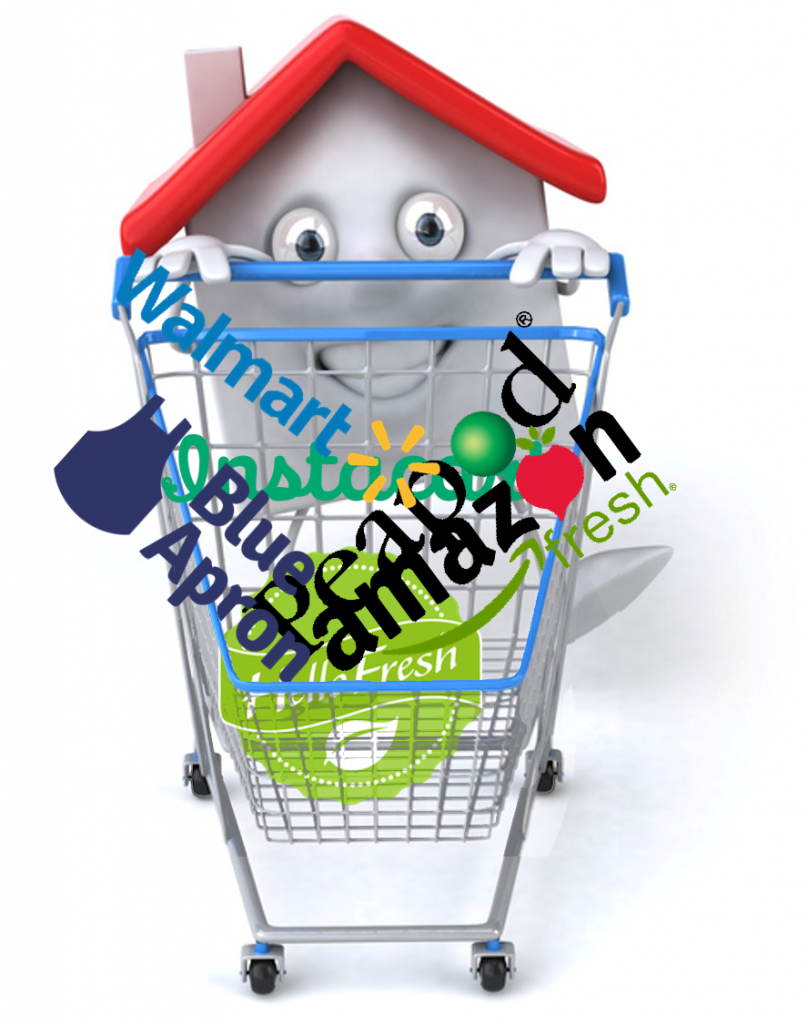Digital disruption has affected nearly every economic sector and the food and drink industry is no exception. While most food and drink stakeholders have concentrated on digitizing their supply chains, increasingly grocers are looking to the consumer side of digitization to grow their business. David Sprinkle, research director for Packaged Facts, states, “Three key factors have created a perfect environment for growth of the online grocery market in the U.S. over the last five years. There’s been increased use of mobile phones and smartphones, interfaces for websites and mobile apps have improved, and there’s been a notable expansion of crowd-sourced business models to shopping and delivery.”[1] He draws those conclusions from a Packaged Facts research report published last year. According to Krishna Thakker (@krishna_thakker), the report also found, “Online grocery sales in the U.S. have tripled since 2013 and are expected to quadruple in the next five years. … The spike is due to the increase in online grocery shopping options and consumers becoming more open to trying the services.”[2] It comes as no surprise that the report found, “Amazon and Walmart continue to be leaders in the market, accounting for 28% of all online sales.” she goes on to note, “Instacart, Kroger, FreshDirect, and Peapod represent all of the other major grocery chains, with Instacart ranking as the largest third-party delivery service. Most of the major growth in online sales have occurred since 2016 as grocers increased participation and expanded their e-commerce platforms.”
Who’s buying groceries online?
Although online grocery shopping remains in its infancy, some members of the greatest generation (consumers born before the Second World War) started to take advantage of home delivery services as they became less mobile. The oldest baby boomers (individuals born between 1946 and 1964) are just starting to face mobility challenges, but have yet to embrace online shopping as a group. Generation X (individuals born between 1965 and 1979), looks like the oldest generation beginning to embrace online grocery shopping. Jennifer Sweeney reports, “The number of Generation X shoppers buying groceries online has grown considerably from 29% in 2018 to 40% in 2019, according to FMI’s new U.S. Grocery Shopper Trends report.”[3] The news about Millennials (aka Generation Y — individuals born between 1980 and 2000) is mixed. Teresa Rivas (@TeresaMRivas) reports, “Online grocery sales are going to be the future of the supermarket, but even among tech-savvy millennials, not many consumers are choosing to shop this way — yet.”[4] On the other hand, Sweeney reports, “Millennials still report a higher frequency of online shopping [than Generation X].” The youngest generation of interest to grocers is Generation Z (individuals born since 2000). Gen Zers’ thoughts about online grocery shopping are just starting to come into focus. Claire Lentsch (@ClaireLentsch) believes online grocery shopping is a good way for Gen Xers’ and millennials to keep in touch with their Gen Z college students. She writes, “The online grocery option is a great way for parents and college students to connect. Many times, students go to college away from home, and parents are unable to go on shopping trips with their child. This new avenue allows for parents to purchase items and have them delivered right to their student’s dorm room or apartment.”[5]
The way ahead
One thing most analysts agree upon is that online grocery shopping is here to stay. Rivas reports Loop Capital’s Anthony Chukumba believes millennials are the key group to watch. He notes, “[Millennials] collective annual spending will reach $1.4 trillion by next year, reflecting 30% of all retail sales.” One of the most promising business models for grocers is the buy online pickup in store (BOPIS) model. Rivas observes, “Those that are ordering groceries online are ordering more, and plenty are choosing to order online and pick up their food in stores. That’s good news for grocers, who then avoid the cost of shipping.” Erica Sacra insists, “The omni-channel experience [for grocers] is no longer a nice-to-have but a need-to-have. More than half of retailers offer mobile shopping app technology to facilitate their shoppers’ buying journeys, though smaller chains are further behind than larger ones when it comes to offering an integrated omni-channel shopping experience.”[6] She suggests grocers concentrate on six areas as they work to strengthen their online grocery sales. They are:
1. Vision, goals and strategies. Sacra recommends grocery executives ask, “What are we trying to accomplish with our business and what technological tools do we need to invest in to help us stay competitive now and in the next five to 10 years?” She adds, “Any consideration of digital transformation must necessarily begin with a clear-eyed vision of what the business is trying to accomplish, both now and in the coming years. … Only once you’ve created a clear vision for the future and articulated a formal case for change will you be able to develop a scalable digital transformation plan that can reliably deliver value against your new technology investment.”
2. Key players. All good business plans concentrate on people, processes, and technology. In the personnel arena, Sacra asks, “Who needs to be involved in various stages of the process?” She adds, “Consider the full workback schedule to determine which key stakeholders and leaders will need to provide input and/or sign off at important stages of the process.”
3. Communicating change. One of the most difficult things for leaders to master is change management. Sacra suggests good communication is key to making change happen. She explains, “Clear and consistent communication is crucial to maintaining loyalty and buy-in of consumers, employees and even suppliers and industry partners. And in the absence of factual communications, people will tend to create their own stories, and rumors can quickly derail the communication process. … Once the new technology is up and running, use both online as well as non-digital tools (think: email and text notifications; inserts in shipped purchases; in-store signage) to communicate the benefits your customers can expect to receive over time. Then, as consumers begin to recognize the real value of your new technology (e.g., they’re able to collect loyalty points more quickly or perhaps they can take advantage of discounts more easily using a new mobile app), capitalize on that momentum using social media channels to shine a spotlight on shoppers who are particularly invested in your brand.”
4. Funding. One of the biggest hurdles to change is determining how it’s going to be funded. Sacra writes, “Depending on your funding models, your company’s grocery e-commerce investment could come out of marketing or IT budgets, or possibly even sales or operations coffers. So, it’s best to investigate which departments will be footing the bill for the new technology well before you sign on the dotted line.”
5. Operations. As I noted above, all good business plans address people, processes, and technology. When it comes to processes, Sacra writes, “Pay careful attention to the areas of your business that are most likely to be affected by the introduction of new e-commerce technology, including IT, procurement, operations, logistics and other departments, as they’re more likely to feel overburdened and undersupported during times of extreme change. And if you’re concerned that those teams could be particularly hard-hit, consider enlisting third-party consultants or outsourced help to see them through ramp-up and rollout phases, until they’re able to settle back into some form of ‘business as usual.’ From procurement, warehousing and shipping capabilities, to back-end office functioning, frontline engagement with shoppers, handling of customer service issues and beyond, no area of a grocery business is left untouched by new technology development and integration.”
6. Security and privacy. Data breaches are one of the quickest ways to lose consumer confidence and support. Sacra writes, “Consumers are willing to share personal information with retailers, especially if it leads to a more personalized and relevant buyer journey. But all that data-sharing can come at a cost — the risk of hacking is ever-present, and could become an even bigger risk as cyber attackers become more sophisticated and more consumer data is collected and stored. You’ll want to ensure that any business-critical data (including retail sales information and customer account details and identifiers like credit card numbers and access codes) is safeguarded from potential cyberattacks.”
With online grocery shopping poised to grow rapidly, mastering the basics of omnichannel operations is essential if grocers want to retain or gain market share. Thakker isn’t optimistic about most grocers’ chances. She writes, “Despite the growing online grocery market, reports note that only a select group of retailers — namely, the big players like Walmart and Amazon — will profit off the service. Deutsche Bank analyst Paul Trussell noted a continuing bifurcation of the market, with investment and innovation driving sales while grocers with me-too offerings give up market share.” Grocers shouldn’t let such predictions stop them from pressing forward. Online grocery shopping remains in its infancy and rising generations of consumers will have a lot to say about how the grocery sector evolves.
Footnotes
[1] Krishna Thakker, “Report: Online grocery sales set to quadruple by 2023,” Grocery Dive, 28 October 2018.
[2] Ibid.
[3] Jennifer Sweeney, “Gen X shifts to grocery shopping online,” Grocery Dive, 19 June 2019.
[4] Teresa Rivas, “Millennials Aren’t Buying Groceries Online — Yet. Retailers Should Get Ready.” Barron’s, 5 February 2019.
[5] Claire Lentsch, “Meet Gen Z: Online Shopping Is Here To Stay,” The Shelby Report, 22 August 2019.
[6] Erica Sacra, “Focus On These Six Key Areas To Win The Grocery E-Commerce Race,” The Shelby Report, 6 September 2019.





